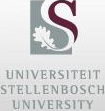A new Cape Willow tree on the front lawn of Wilgenhof men's residence on the corner of Ryneveld and Victoria Street in Stellenbosch symbolises a new beginning in a renovated residence.
Wilgenhof celebrated their return to a refurbished building and reintegration to the student community with a special tree planting ceremony on Friday afternoon, 25 July. Following a decision by the Stellenbosch University (SU) Council on 16 September 2024 to close the Wilgenhof Residence – and the extensive discussions between the University, students, parents, alumni and former Wilgenhof residents that followed – the residence closed for the first semester of 2025 to be refurbished in totality. Students moved back in the beginning of the second semester after the building reopened on Friday, 18 July.
The ceremony was attended by Wilgenhof house committee members and residents; members of the SU Rectorate; representatives of the Wilgenhof Alumni Association; representatives of the Division for Student Affairs, the Division for Development and Alumni Relations, the Corporate Communication and Marketing Division, Facilities Management and the Prim Committee; student leaders; Dr Wilhelm Verwoerd, a facilitator in the Wilgenhof Rejuvenation Process; and Judge Edwin Cameron, former SU Chancellor and primarius of Wilgenhof.
Prof Deresh Ramjugernath, SU Rector and Vice-Chancellor, said the reintegration of the Wilgenhof community into the historic building, is done “with a shared sense of purpose, namely, to recognise the past, to acknowledge the present, and to commit ourselves to a future rooted in respect, renewal, and unity".
“The act of planting a tree is a gesture of growth, regeneration, and a long-term commitment. It also signifies the evolving relationship between Wilgenhof, SU and the broader university community. Wilgenhof has undergone, and will continue to undergo, a process of deep reflection and renewal. The word 'renewal' is intentionally powerful, because it's not only structural. It is also emotional and cultural, and above all, it provides hope.
“The events that have led us to today have been challenging. It has involved difficult conversations, critical decisions, and courageous leadership from many sides. The newly imagined Wilgenhof is now aligned with the values and principles that guide our broader residence community. It is a space where dignity, learning, accountability, and mutual respect are not negotiable, but foundational.
“Wilgenhof is not stepping back into the past. It is stepping forward into a renewed commitment to transformation and inclusion. Today we not only planted a tree, but a promise. Our promise, and our hope, is that this space, and the people who inhabit it, will continue to grow. Let it be a reminder that transformation is not an endpoint, but an ongoing process – and when rooted in shared values, it can thrive. May this tree, and this moment, stand as a living symbol of what we can achieve together," said Ramjugernath.
Mr Neil Botha, primarius of Wilgenhof, said the journey was extremely difficult, but he is thankful to have reached the point of where they are now. He said the tree symbolises a new beginning.
“I truly hope that this is the beginning of the friendship with the University that I was hoping for. I feel very hopeful. It was not easy to be a Wilgenhoffer during the past 18 months. However, we realise the two rooms were an embarrassment to the University. It was not our intent, but a part of going forward is an acknowledgement of what have happened."
Mr Nico de Waal, chair of the Wilgenhof Alumni Association, said the tree planting ceremony is testimony to a common commitment to rejuvenation.
“I want to repeat our sincere apology to the embarrassment that SU has suffered. The vast majority of Wilgenhoffers had different experiences than what was conveyed in the media, but we as alumni are in full support of the facilitation process and we are impressed by the facilitating team."
Mr Ashmind Daniels, Wilgenhof Residence Head, said the planting of a tree is a symbolic act of renewal, growth, and the enduring commitment of the Wilgenhof community.
“Just as this tree will take root and grow over time, so too must we, as a community, be rooted in values that sustain and uplift. May this tree serve as a living reminder of the care, accountability, and pride we carry for Wilgenhof – not only as a building, but as a shared home. The tree speaks to what we can achieve if we work together," said Daniels.
The Cape Willow (Salix mucronate) is a semi-deciduous, fast-growing, indigenous tree that can grow up to 15 meters. The planting of trees contributes to increasing the University's biodiversity and is part of the SU Environmental Sustainability plan to reduce the carbon footprint on campus. The biodiversity part of the plan aims to maintain and design all landscapes to be resilient to environmental change and to improve biodiversity and the sustainability of open spaces.
* The student-led and facilitated Wilgenhof Rejuvenation Process, under the leadership of Prof Pumla Gobodo-Madikizela, is intended to mark a decisive break from the past and foster a renewed residence culture grounded in inclusivity, transparency, and shared values. This process is ongoing and continuous and not concluded yet.

